|
When I first saw the Piccolo Teatro of Milano, in the seventies, Giorgio Strehler was one of the undisputed masters of European theater, and his production of Arlecchino, Servant of Two Masters, was a sensation. 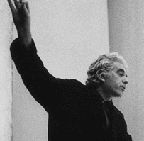 In 1949, Strehler had single-handedly resuscitated the ancient tradition of commedia dell' arte. Commedia dell'arte had been all but forgotten, and his production of Goldoni's Arlecchino reinvented it. In 1949, Strehler had single-handedly resuscitated the ancient tradition of commedia dell' arte. Commedia dell'arte had been all but forgotten, and his production of Goldoni's Arlecchino reinvented it.
I remember the dizzying effect of acrobatics in the peak scene, when Arlecchino literally serves two tables (invisible in the wings), racing back and forth across the entire stage, while plates, sausages, and soup terrines are flying in the air. He catches them with one hand and with the other tosses the empty dishes back to the kitchen and to three other servants. Seeing any actors in real motion was a memorable experience at a time when theater had only begun to break out of the stiffness of declamatory bourgeois conventions. I was curious to see how this would work today, after all the theatrical revolutions brought about by the Living Theater, Grotowski, Pina Bausch, Robert Wilson, Richard Foreman, etc. The Piccolo Teatro was invited by Cal Performances, and I was especially curious about Arlecchino himself for the role was played by none other than Ferruccio Soleri, the same actor I had seen so many years ago.
In the reinvented Commedia dell'arte tradition of the Piccolo Teatro, the stock characters and their peculiar black leather masks are created by the actors for a lifetime. 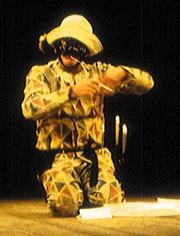 Each role with its particular Italian dialect and accent, voice and movement characteristics belongs to one person alone. But when the company is on tour, one apprentice or understudy gets a chance to step into the big shoes of the principal actor and perform. This is how Ferrucio Soleri got his chance, on a New York tour in 1960. He took over for good in 1963 and has been Arlecchino for 58 years, performing the role about 2400 times, traveling with the company an equivalent of 20 times around the world. Each role with its particular Italian dialect and accent, voice and movement characteristics belongs to one person alone. But when the company is on tour, one apprentice or understudy gets a chance to step into the big shoes of the principal actor and perform. This is how Ferrucio Soleri got his chance, on a New York tour in 1960. He took over for good in 1963 and has been Arlecchino for 58 years, performing the role about 2400 times, traveling with the company an equivalent of 20 times around the world.
In an interview with Soleri, the 76 year-old actor explained how he keeps himself fit for the role: by living on the 6th floor without an elevator; by using extreme economy of movement before and during the performance, and by being so gruff that nobody dares talk to him while he is at work. In a superb mini performance, the ordinary-looking, small old man donned the masks and demonstrated the main characters of Commedia dell' arte: the old men -- the money-loving merchant Pantalone from Venice with his bird mask, the big-bellied Dottore from Bologna who speaks in kitchen Latin and wears a short pig mask for unimpeded eating; and the young men – the clever inn keeper Brighella from Bergamote with a greedy-dog mask, and of course the foolish, childish servant Arlecchino who wears a black stocking on his head and a cat mask with a (devil's?) horn. Within seconds, each type of man was created simply through their typical body positions. The effect was magical – more so, it turned out, than the entire play.
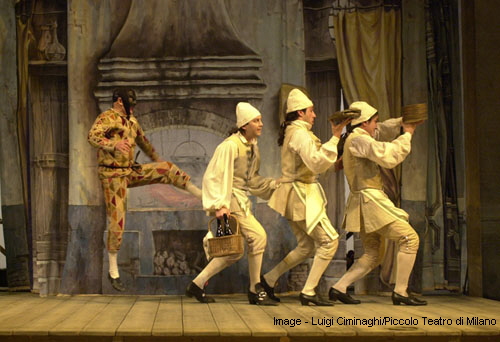 |
My dizzying experience in Paris did not repeat itself. There was great visual beauty in the little improvisational stage that was set up as if the traveling company had just arrived in a market place between old Italian villas. Or as if some Count Almaviva or Don Giovanni had invited the comedians to his court for a performance. "Off-stage," so to speak, the actors were coming and going, sitting around the little stage, sewing, sometimes commenting, leaning against the walls and "hanging out" in this scenery of golden Italian light, while they were waiting for their next moment "on-stage." There were wonderful moments of comic pantomime and clowning in this story of a young girl promised to two prospective husbands and a servant trying to profit from the confusion. The acrobatic peak scene was still a marvel, but Soleri was so laid-back in his movement "economy" that he seemed almost unengaged. In his big scene he hardly kept up with the timing and made a number of mistakes, dropping platters and missing the kitchen curtain when he tossed the plates back. I had to sadly admit that he might be getting old, after all, when I saw the young Enrico Bonavera, the stand-in, the next-generation-Arlecchino, in the matinee performance. Bonavera displayed the electric, hyperactive, bouncing child energy needed for the part.
But even then, I found myself not terribly impressed by the physical performances. Certainly after last year's amazing Broadway-trained actors in Robert Wilson's Black Rider or the brilliant cast of Canadians in the wordless rendition of Gogol's The Overcoat (directed by Morris Panych and Wendy Gorling to music by Shostakovich), the Piccolo Teatro fell somewhat flat. The characters seemed stayed, all too predictable, the caricature without true bite, like in a Punch and Judy show of old. In spite of the hectic and chaotic loudness and wordiness of the play, I sensed a deadness in this attempt to keep an ancient tradition alive... by mere repetition. It reminded me of seeing Balanchine being danced today, or seeing Brecht's Berliner Ensemble during the time of the Berlin Wall, when the spirit of that stage was crushed and as dead as stone. Watching this Arlecchino was more educational than edifying – a nostalgic reminder of a long-gone past that gave rise to characters like Figaro, Zerlina, Despina, Rosina or the Barber of Seville. If Strehler (who died in 1997) were still alive, perhaps he would come up with some fresh satirical surprises or some contemporary twists –like letting men play the women's roles, for example, or vice versa. Without him, the Piccolo Teatro seemed like a museum, stifled by its own tradition.
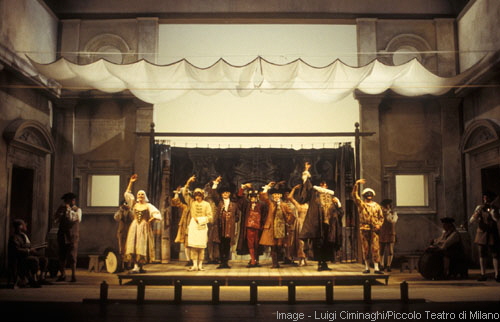 |
A Winter's Tale
Only a few days later, a group from England proved that a very old theater tradition can be alive and kicking. All-male theater companies playing Shakespeare have become a new fad on both sides of the Atlantic, tracking back to the Elizabethan theater that did not allow women to appear on stage. Propeller, a group based at the Watermill Theatre in Newbury, had created a buzz with A Midsummer Night's Dream, in 2004, and now again with A Winter's Tale.
A Winter's Tale is a strange, stylistically uneven play from what appears to be an "experimental phase" in Shakespeare's late years. The play mixes high drama à la Othello with extensive bucolic buffoonery and a sudden "romantic" fairytale ending (which in this production is turned into a hauntingly pessimistic ending.) Leontes, a suspicious, paranoid king throws his innocent wife Hermione into the Tower and sets his newly born daughter Perdita out to die in the wild. Leontes regrets and mourns his dead, but after 16 years, they suddenly both reappear.  Director Edward Hall, son of the famous director of the Royal Shakespeare Company, Peter Hall, does not attempt to put any order or logic into this messy story. He takes the play as a moment-by-moment invitation to unfettered theatrical invention, mixing time frames and costumes from ancient to modern, adding dances and musical instruments, folk songs and jazz, executed with aplomb by the dozen actors who are clearly having a great time with it all. Director Edward Hall, son of the famous director of the Royal Shakespeare Company, Peter Hall, does not attempt to put any order or logic into this messy story. He takes the play as a moment-by-moment invitation to unfettered theatrical invention, mixing time frames and costumes from ancient to modern, adding dances and musical instruments, folk songs and jazz, executed with aplomb by the dozen actors who are clearly having a great time with it all.
Seeing all the roles acted by men seemed to me a fitting experimental touch, showing both loyalty to the Bard's tradition and attunement to the zeitgeist. I have always wondered how these Shakespearean heroines were originally represented on the stage? In the exaggerated fashion of the transvestite style that has become a cabaret fashion in more recent times? Relishing in the Über-feminine of female impersonation?
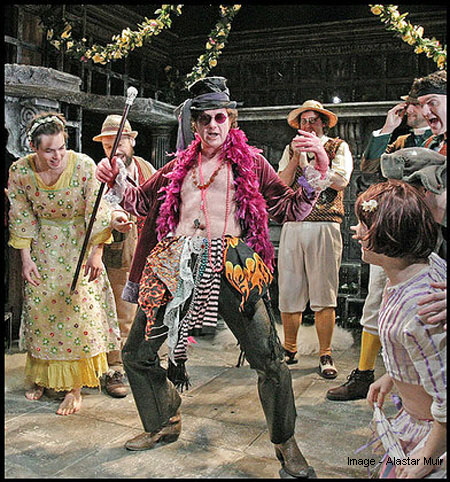 |
Edward Hall takes the opposite approach. He allows his men to be "natural" men in the role of women, even though they wear dresses or a simple feminine accessory like a shawl or hair adornment. Women are not impersonated, they are presented as characters in the same way the male roles are. The actors are obviously chosen for their more androgynous leanings, and the effect is intriguing. Big-footed, with big thighs and strong voices, Hermione, Paulina and Perdita gain undeniable power and authority in this experiment. Devoid of "femininity" they become unusually interesting "human beings."
The rather stiff, flat-footed male walk of Simon Scardifield, for example, can be read as a convincing waddle for the highly pregnant Queen Hermione. When she leaves the Tower to appear in court, wearing a bloodstained slip, the actor's naked, bony face seems to project the deprivation and depravation of prison. Paulina's (Adam Levy) usually hysterical rants in defense of her queen gain the status of rightful indignation coming from a man. Perdita's (Tam Williams) boyish awkwardness and edginess add to the psychology of a princess raised in a shepherd's hut – most likely as a tomboy. And in the bucolic scenes, the hairy midriffs of the not particularly charming milkmaids add a charming comical touch.
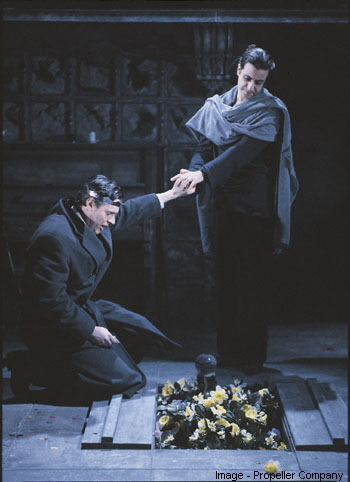 |
Edward Hall has made an intriguing comment on this traditional and at the same time modern physical aesthetic: "What's interesting about men playing women is that the audience stops being interested in the sexual chemistry between the actors and starts listening to the words." Was he talking about an (imaginary) exclusively heterosexual audience? Could this be a misogynous statement that implies actresses can't easily be listened to? Or, that women need to change their gender in order to bring their message across? For me, the opposite was the case. I was distracted from listening (Propeller's diction is non-declamatory to a fault and a few actors – in particular Vincent Leigh as Leontes – mumbled in a strong British accent) by the sexual chemistry of gender as such.
I kept observing and enjoying the gender shifts, noticing any mark or move that seemed "right" or "wrong" according to the gender rule. Our habit of perceiving people according to gender is so deeply ingrained that gender cannot be entirely erased, no matter how fluid the shift appears between masculine or feminine traits and perceptions. Sometimes the male actors appeared like a new blend, a sort of "other," third-sex species. Sometimes they came across as genderless, blank slates inviting my mind to project the feminine or masculine back onto those slates. And there were many surprising and touching moments of "women" created on the stage, bringing home the fact that so much of our gender is but a performance, a theatrical illusion. Or, to quote a famous line from the play: "If this be magic, let it be an art..."
The Tempest
Pure art, pure magic were at play, this fall, in Lillian Groag's staging of Shakespeare's The Tempest, at the California Shakespeare Festival in Orinda. The company has developed into one of the most reliably satisfying theaters in the San Francisco Bay Area. 2005 has been an outstanding season with a brilliant Othello (directed by Sean Daniels), a highly entertaining 2-part Nicholas Nickleby (Jonathan Moscone and Sean Daniels) and, as a crowning finale, The Tempest. The outdoor festival, surrounded by the postcard beauty of golden hills and oak coves, has often seemed a perfect frame for certain Shakespeare plays. I remember a King Lear when a storm rose up out of the blue, just in time for the deluge in the play. But this time, the effect had been nicely calculated. In this new production of The Tempest, Prospero's island is just another line of sandy hills on the stage among those hills. The actors appear and disappear over it: Ariel (Mhari Sandoval) comes leaping and flying across the mounds in the shape of a bird, hands aflutter, the breeze blowing her blue, diaphanous tunic and the little Blue Jay feathers in her hair. Behind her, the occasional real bird makes a blue appearance flitting though the trees. At moments of dramatic intensity, her voice echoes with electronic amplification and distortion, turning into the shriek of a bird of prey.
Ariel's companions, the other island Spirits, are bird creatures, too. Eight of them, dressed in simple off-white tunics, hover right behind the crest, raise their quail-feathered heads and crane their necks to spy on the human shipwrecks who have invaded their space. Their chirps and chatters are part of the strange music of the isle, and their arch or deadpan facial expressions add to the amusement of Prospero's mise en scène of bewitched happenings. They sneak up on the courtiers to tease and torment them with optical illusions and physical delusions. When the invaders talk about the enchanting perfumes of the island, the spirits swing gigantic flowers hypnotically in front of their noses. When the traitors make snide remarks, an instant whack and sting from a "bug" hanging on a stick by a string is their reward. When young Prince Ferdinand carries his wood loads to mollify Prospero and woo the Duke's daughter Miranda, the bird creatures spirit the wood around the stage, adding a comical touch to the confusion of the young man who has already lost his head. They play tricks on drunken Stephano (Ron Campbell) and his bottle, and on the jester Trinculo (Jud Williford) with his suspicions of the island's mysteries: holding up a little black cloud, one Spirit follows him like a shadow, forcing Trinculo to try tricking his way out from under the menace over his head.
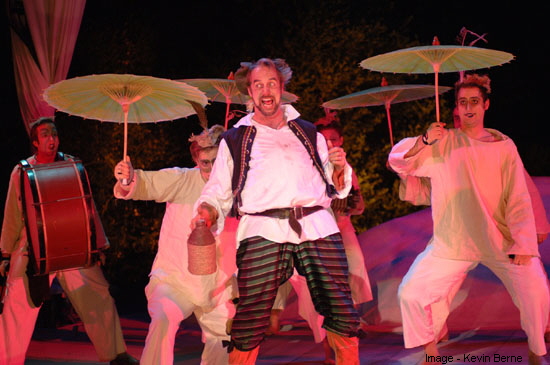
This wordless "chorus" of sprites takes on a role of similar importance to that of the Greek chorus. Their interference becomes an inspired commentary that does much more than make magic visible on-stage. They not only lend The Tempest a tender touch of comedy, but they offer a feather-light clarification, sort of an "explication de texte." They "translate" Shakespeare's archaic words and word games into a sensual, sensuous realm, into instantly readable and enjoyable apparitions.
The charm of quick-silvery and rapacious Ariel and her companions is astonishingly matched by the picture book embodiment of the other characters: Elizabeth Schmidt is a true fairytale princess and Asa Taccone as her little prince looks just as innocent and fits her to a T. When Prospero reveals the young couple to his "guests," the poetic image of Miranda and Ferdinand playing chess on top of the sand dune, sends a shock wave of delight not just to the King and his courtiers, but through the entire amphitheater. As the noble ruler of the isle, Anthony Fusco is a mesmerizing Prospero, still young and passionate enough to have to struggle for his serenity.
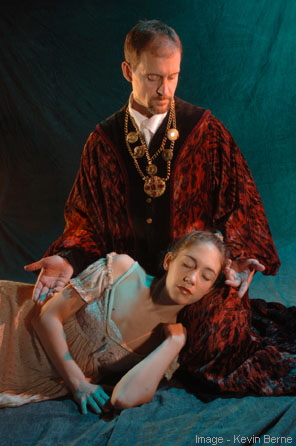 |
The dark force of nature, Caliban, beautifully embodied and played by Triney Sandoval, has the wildness of a great forsaken beast and the sadness of a man cruelly caught between id and civilization, tragically yearning for companionship and love. In the end, Lillian Groag's direction redeems the beast who is left behind alone on the isle, by letting him be drawn to music – the most enchanting music imaginable: Mozart's good-bye trio "Suave sia il vento" from Così fan tutte. Just as touchingly, Prospero is released from his own demons, the pain he set out to master by controlling the spirits of the isle. Lillian Groag's reading of the play shows that a part of Prospero's resentment is in fact Caliban's rage; and that Ariel's touch and wild yearning for freedom allows him to embrace his own loss and find the spirit of forgiveness.
A touch of bitterness remains in the end. The original culprit, Prospero's usurping brother Antonio (Andy Murray), who has no final lines in the play, silently rejects the offer of pardon and the embrace from his brother, but this shadow only highlights Prospero's achievement. In this production of The Tempest, Prospero's renunciation of magic, of Ariel, of an active role in the world, leaves the impression that Shakespeare's latest play, the only one apparently not based on someone else's story, is his most personal work. It comes across as a testament on how one single spirit, through the magic of art, can achieve reconciliation, and through reconciliation, magically changes the world.
|